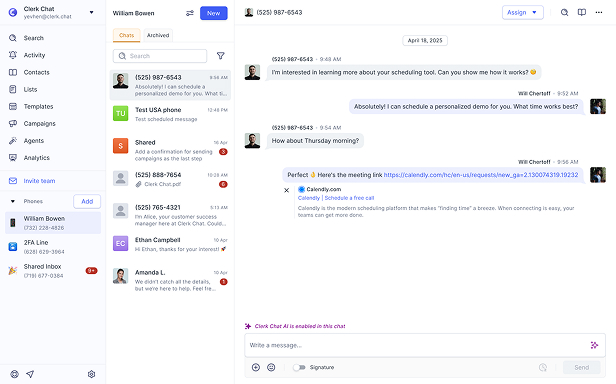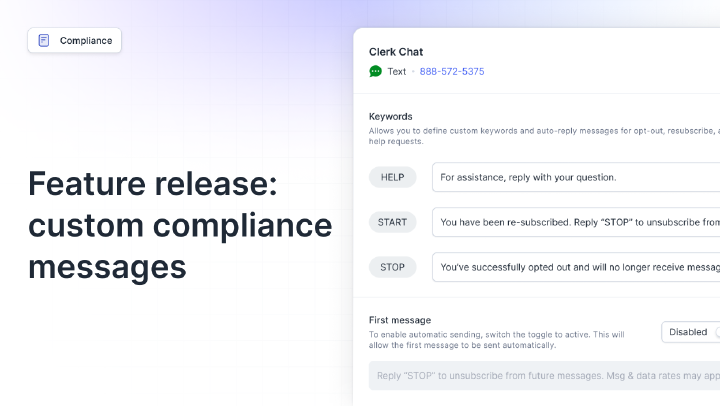Short Code
[ʃɔːrt koʊd]A short code is a 5- or 6-digit phone number used by businesses to send high-volume SMS messages. These numbers are ideal for promotions, alerts, or event-based messaging due to their fast throughput and strong carrier reputation.
Why short code matters
When timing and deliverability are critical, short codes are the go-to choice. They’re approved by mobile carriers for high-throughput SMS - often sending hundreds of messages per second. This makes them ideal for flash sales, voting campaigns, emergency alerts, or live event interactions.
Short codes are pre-vetted by carriers, giving them higher trust and delivery rates. They’re also easier for recipients to recognize and remember - important for brand recall and engagement. Although more expensive than long codes or toll-free numbers, the performance and reliability they offer often justify the investment for large-scale use cases.
Businesses using Clerk Chat can integrate their short code into the platform to leverage message templates, automation, and compliance features at scale.
How short code works
Here’s how short code messaging works in a typical business setup:
- Lease the short code – Businesses apply for a short code (random or vanity) through an aggregator or platform.
- Submit use case – Carriers require a clear outline of how the short code will be used (alerts, voting, marketing, etc.).
- Carrier approval – Messaging content and frequency are reviewed for compliance and customer protection.
- Provisioning – Once approved, the short code is connected to a platform like Clerk Chat via API.
- Message sending – Businesses can now launch mass SMS campaigns at high throughput speeds.
- Compliance management – Include opt-out keywords, monitor responses, and track deliverability metrics.
Because short codes are regulated tightly, proper setup is essential - but the reward is reliable, large-scale reach.
Best practices with short code
Choose dedicated over shared - A dedicated short code offers better branding and fewer risks.
Get pre-approval for your use case - Always align messaging plans with what’s approved by carriers.
Use clear, concise messages - Short codes are best for short, time-sensitive updates.
Provide opt-out instructions - Even promotional content must include a STOP option.
Track delivery and engagement - Monitor bounce rates, response times, and opt-out rates closely.
Avoid over-messaging - Even though throughput is high, frequency abuse can lead to customer churn or carrier penalties.
Include your brand in the message - Since short codes aren’t associated with a business name directly, identify yourself clearly.
Real world examples
- Retail
Sent flash sale alerts with 99.5% delivery using a dedicated short code.
Read more - Nonprofits
Used short codes to collect over 5,000 SMS donations during live events.
Read more
Common misconceptions
Short codes are still widely used for high-volume messaging like alerts and promotions.
They require leasing and setup through carriers - costs vary based on whether it’s shared or dedicated.
All short code use cases must be approved by carriers to ensure content compliance.
Some do, but they’re primarily used for outbound campaigns, not full conversations.
It typically takes 6–8 weeks to lease and provision a short code through carriers.
Related terms
In this article:
Ready to use your business number for text messaging?
Thousands of businesses are already experiencing the power of conversational messaging through SMS. Join us. Free trial and paid tiers available.
Get StartedFAQ
Have questions? We've got answers.
Find what you need quickly and clearly with our most frequently asked questions.
A short code is a 5- or 6-digit number businesses use to send and receive SMS messages at high volume. They are commonly used for promotions, alerts, donations, and time-sensitive campaigns.
Short codes support much higher throughput and are used for mass messaging. Long codes look like regular phone numbers and are better for two-way conversations and personalized support.
No. Leasing and provisioning a short code typically takes 6 to 8 weeks, including carrier approvals. You’ll also need to register your messaging use case.
Shared short codes are used by multiple businesses (less common now due to compliance). Dedicated short codes are exclusive to your business and offer full control and branding.
Yes. Short codes typically cost hundreds to thousands of dollars per month, depending on whether they’re dedicated or vanity. But they deliver unmatched speed and reliability at scale.
Yes. Clerk Chat can connect to your leased short code and support high-volume campaign messaging, including opt-out handling, scheduling, and analytics.




